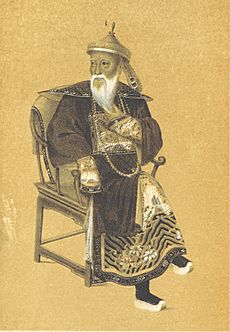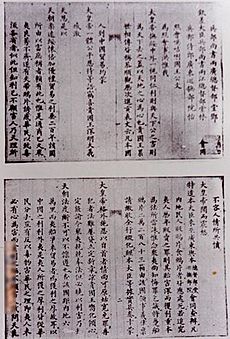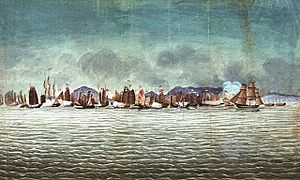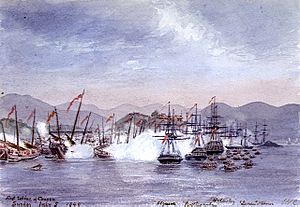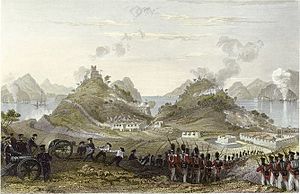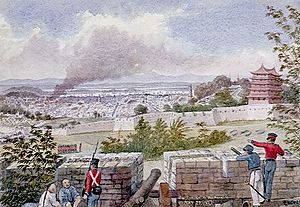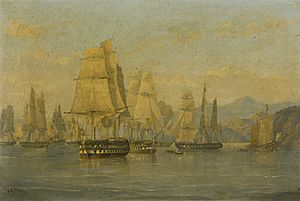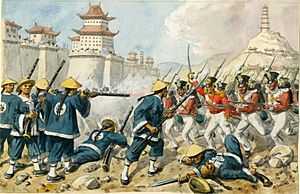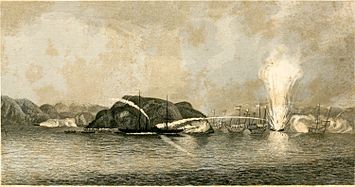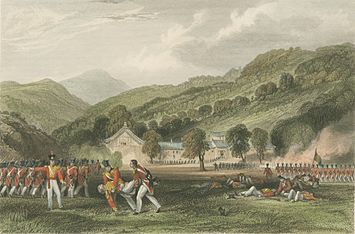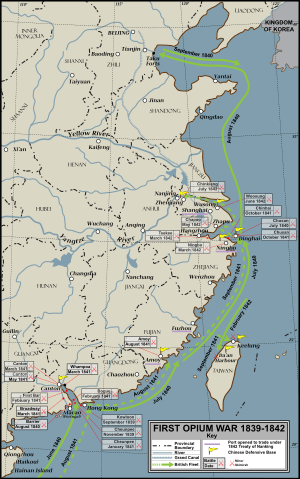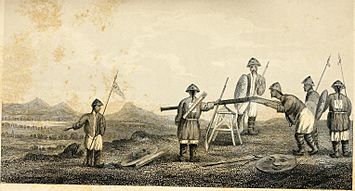First Opium War facts for kids
Quick facts for kids First Opium War |
|||||||||
|---|---|---|---|---|---|---|---|---|---|
| Part of the Opium Wars | |||||||||
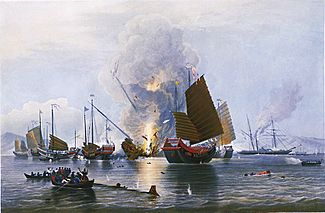 The East India Company steamship Nemesis (right background) destroying war junks during the Second Battle of Chuenpi, 7 January 1841 |
|||||||||
|
|||||||||
| Belligerents | |||||||||
| Commanders and leaders | |||||||||
|
|
||||||||
| Strength | |||||||||
|
19,000+ troops:
37 ships:
|
222,212 total troops ( only about 100,000 were actually mobilised ):
|
||||||||
| Casualties and losses | |||||||||
|
est. 3,100 killed 4,000 wounded |
||||||||
| First Opium War | |||||||||||||
|---|---|---|---|---|---|---|---|---|---|---|---|---|---|
| Traditional Chinese | 第一次鴉片戰爭 | ||||||||||||
|
|||||||||||||
The First Opium War (Chinese: 第一次鴉片戰爭; pinyin: Dìyīcì Yāpiàn Zhànzhēng), also known as the Anglo-Sino War was a series of military engagements fought between Britain and the Qing dynasty of China between 1839 and 1842. The immediate issue was the Chinese enforcement of their ban on the opium trade by seizing private opium stocks from merchants at Canton and threatening to impose the death penalty for future offenders. Despite the opium ban, the British government supported the merchants' demand for compensation for seized goods, and insisted on the principles of free trade and equal diplomatic recognition with China. Opium was Britain's single most profitable commodity trade of the 19th century. After months of tensions between the two nations, the British navy launched an expedition in June 1840, which ultimately defeated the Chinese using technologically superior ships and weapons by August 1842. The British then imposed the Treaty of Nanking, which forced China to increase foreign trade, give compensation, and cede Hong Kong to the British. Consequently the opium trade continued in China. Twentieth century nationalists consider 1839 the start of a century of humiliation, and many historians consider it the beginning of modern Chinese history.
In the 18th century, the demand for Chinese luxury goods (particularly silk, porcelain, and tea) created a trade imbalance between China and Britain. European silver flowed into China through the Canton System, which confined incoming foreign trade to the southern port city of Canton. To counter this imbalance, the British East India Company began to grow opium in Bengal and allowed private British merchants to sell opium to Chinese smugglers for illegal sale in China. This trade reversed the Chinese trade surplus, drained the economy of silver, and had an evil impact on the Chinese people, outcomes that seriously worried Chinese officials.
In 1839, the Daoguang Emperor appointed Viceroy Lin Zexu to go to Canton to halt the opium trade completely. Lin wrote an open letter to Queen Victoria, which she never saw, appealing to her moral responsibility to stop the opium trade. Lin then resorted to using force in the western merchants enclave. He arrived in Guangzhou at the end of January and organized a coastal defense. In March, British dealers were forced to hand over 2.37 million pounds of opium. On 3 June, Lin ordered the opium to be destroyed in public on Humen Beach to show the Government's determination to ban smoking. All other supplies were confiscated and a blockade of foreign ships on the Pearl River was ordered.
Tensions escalated in July after British sailors killed a Chinese villager and the British government refused to hand the accused men over to Chinese authorities. Fighting later broke out, with the British navy destroying the Chinese naval blockade, and launching an offensive. In the ensuing conflict, the Royal Navy used its superior naval and gunnery power to inflict a series of decisive defeats on the Chinese Empire. In 1842, the Qing dynasty was forced to sign the Treaty of Nanking—the first of what the Chinese later called the unequal treaties—which granted an indemnity and extraterritoriality to British subjects in China, opened five treaty ports to British merchants, and ceded Hong Kong Island to the British Empire. The failure of the treaty to satisfy British goals of improved trade and diplomatic relations led to the Second Opium War (1856–60). The resulting social unrest was the background for the Taiping Rebellion, which further weakened the Qing regime.
Contents
Background
Establishment of trade relations
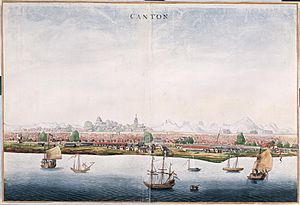
Direct maritime trade between Europe and China began in 1557 when the Portuguese leased an outpost from the Ming dynasty in Macau. Other European nations soon followed the Portuguese lead, inserting themselves into the existing Asian maritime trade network to compete with Arab, Chinese, Indian, and Japanese merchants in intra-regional commerce. After the Spanish conquest of the Philippines the exchange of goods between China and Europe accelerated dramatically. From 1565, the Manila Galleons brought silver into the Asian trade network from mines in South America. China was a primary destination for the precious metal, as the imperial government mandated that Chinese goods could only be exported in exchange for silver bullion.
British ships began to appear sporadically around the coasts of China from 1635 on. Without establishing formal relations through the Chinese tributary system, by which most Asian nations were able to negotiate with China, British merchants were only allowed to trade at the ports of Zhoushan, Xiamen, and Guangzhou. Official British trade was conducted through the auspices of the British East India Company, which held a royal charter for trade with the Far East. The East India Company gradually came to dominate Sino-European trade from its position in India and due to the strength of the Royal Navy.
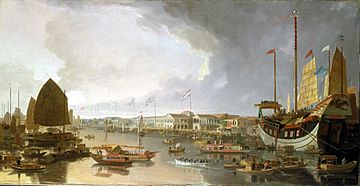
Trade benefited after the newly risen Qing dynasty relaxed maritime trade restrictions in the 1680s. Formosa (Taiwan) came under Qing control in 1683 and rhetoric regarding the tributary status of Europeans was muted. Guangzhou (known as Canton to Europeans) became the port of preference for incoming foreign trade. Ships did try to call at other ports, but these locations could not match the benefits of Canton's geographic position at the mouth of the Pearl River, nor did they have the city's long experience in balancing the demands of Beijing with those of Chinese and foreign merchants. From 1700 onward Canton was the center of maritime trade with China, and this market process was gradually formulated by Qing authorities into the "Canton System". From the system's inception in 1757, trading in China was extremely lucrative for European and Chinese merchants alike as goods such as tea, porcelain, and silk were valued highly enough in Europe to justify the expenses of traveling to Asia. The system was highly regulated by the Qing government. Foreign traders were only permitted to do business through a body of Chinese merchants known as the Cohong and were forbidden to learn Chinese. Foreigners could only live in one of the Thirteen Factories and were not allowed to enter or trade in any other part of China. Only low-level government officials could be dealt with, and the imperial court could not be lobbied for any reason excepting official diplomatic missions. The Imperial laws that upheld the system were collectively known as the Prevention Barbarian Ordinances (防範外夷規條). The Cohong were particularly powerful in the Old China Trade, as they were tasked with appraising the value of foreign products, purchasing or rebuffing said imports and charged with selling Chinese exports at an appropriate price. The Cohong was made up of between (depending on the politics of Canton) 6 to 20 merchant families. Most of the merchant houses these families ruled had been established by low-ranking mandarins, but several were Cantonese or Han in origin. Another key function of the Cohong was the traditional bond signed between a Cohong member and a foreign merchant. This bond stated that the receiving Cohong member was responsible for the foreign merchant's behavior and cargo while in China. In addition to dealing with the Cohong, European merchants were required to pay customs fees, measurement duties, provide gifts, and hire navigators.
Despite restrictions, silk and porcelain continued to drive trade through their popularity in Europe, and an insatiable demand for Chinese tea existed in Britain. From the mid-17th century onward around 28 million kilograms of silver were received by China, principally from European powers, in exchange for Chinese products.
European trade deficits
A brisk trade between China and European powers continued for over a century. While this trading heavily favoured the Chinese and resulted in European nations sustaining large trade deficits, the demand for Chinese goods continued to drive commerce. In addition, the colonisation and conquest of the Americas resulted in European nations (namely Spain, Great Britain, and France) gaining access to a cheap supply of silver, resulting in European economies remaining relatively stable despite the trade deficit with China. This silver was also shipped across the Pacific Ocean to China directly, notably through the Spanish-controlled Philippines. In stark contrast to the European situation, Qing China sustained a trade surplus. Foreign silver flooded into China in exchange for Chinese goods, expanding the Chinese economy but also causing inflation and forming a Chinese reliance on European silver.
The continued economic expansion of European economies in 17th and 18th centuries gradually increased the European demand for precious metals, which were used to mint new coins; this increasing need for hard currency to remain in circulation in Europe reduced the supply of bullion available for trade in China, driving up costs and leading to competition between merchants in Europe and European merchants who traded with the Chinese. This market force resulted in a chronic trade deficit for European governments, who were forced to risk silver shortages in their domestic economies to supply the needs of their merchants in Asia (who as private enterprises still turned a profit by selling valuable Chinese goods to consumers in Europe). This gradual effect was greatly exacerbated by a series of large-scale colonial wars between Great Britain and Spain in the mid 18th century; these conflicts disrupted the international silver market and eventually resulted in the independence of powerful new nations, namely the United States and Mexico. Without cheap silver from the colonies to sustain their trade, European merchants who traded with China began to take silver directly out of circulation in the already-weakened economies of Europe to pay for goods in China. This angered governments, who saw their economies shrink as a result, and fostered a great deal of animosity towards the Chinese for their restriction of European trade. The Chinese economy was unaffected by fluctuations in silver prices, as China was able to import Japanese silver to stabilise its money supply. European goods remained in low demand in China, ensuring the longstanding trade surplus with the European nations continued.
Changing trade policy
In addition to the start of the opium trade, economic and social innovations led to a change in the parameters of the wider Sino-European trade. The formulation of classical economics by Adam Smith and other economic theorists caused academic belief in mercantilism to decline in Britain. Under the prior system, the Qianlong Emperor restricted trade with foreigners on Chinese soil only for licensed Chinese merchants, while the British government on their part issued a monopoly charter for trade only to the British East India Company. This arrangement was not challenged until the 19th century when the idea of free trade was popularised in the West. Fueled by the Industrial Revolution, Britain began to use its growing naval power to spread a broadly liberal economic model, encompassing open markets and relatively barrier free international trade, a policy in line with the credo of Smithian economics. This stance on trade was intended to open foreign markets to the resources of Britain's colonies, as well as provide the British public with greater access to consumer goods such as tea. In Great Britain, the adoption of the gold standard in 1821 resulted in the empire minting standardised silver shillings, further reducing the availability of silver for trade in Asia and spurring the British government to press for more trading rights in China.
In contrast to this new economic model, the Qing dynasty continued to employ a Confucian-Modernist, highly organised economic philosophy that called for strict government intervention in industry for the sake of preserving societal stability. While the Qing government was not explicitly anti-trade, a lack of need for imports and increasingly heavy taxes on luxury goods limited pressure on the government to open further ports to international trade. China's rigid merchant hierarchy also blocked efforts to open ports to foreign ships and businesses. Chinese merchants operating in inland China wanted to avoid market fluctuations caused by importing foreign goods that would compete with domestic production, while the Cohong families of Canton profited greatly by keeping their city the only entry point for foreign products.
At the turn of the 19th-century countries such as Great Britain, the Netherlands, Denmark, Russia, and the United States began to seek additional trading rights in China. Foremost among the concerns of the western nations was the end of the Canton System and the opening of China's vast consumer markets to trade. Britain in particular was keenly increasing its exports to China, as the empire's implementation of the gold standard forced it to purchase silver and gold from continental Europe and Mexico to further fuel its rapidly industrialising economy. Attempts by a British embassy (led by Macartney in 1793), a Dutch mission (under Jacob van Braam in 1794), Russia (headed by Yury Golovkin in 1805), and the British again (Earl William Amherst in 1816) to negotiate increased access to the Chinese market were all vetoed by successive Qing Emperors. Upon his meeting the Jiaqing Emperor in 1816, Amherst refused to perform the traditional kowtow, an act that the Qing saw as a severe breach of etiquette. Amherst and his party were expelled from China, a diplomatic rebuke that angered the British government.
One major reason was that British consumers had developed a strong liking for Chinese tea, as well as other goods like porcelain and silk. But Chinese consumers had no similar preference for any goods produced in Britain. Because of this trade imbalance, Britain increasingly had to use silver to pay for its expanding purchases of Chinese goods. Britain suffered from a huge trade deficit during the Sino-British trade. Meanwhile, the high tariff made the British government very dissatisfied with the Qing government. The Chinese only allowed silver in exchange for the products they were offering so a significant amount of this commodity was leaving the British Empire.
As its merchants gained increasing influence in China, Great Britain bolstered its military strength in Southern China. Britain began sending warships to combat piracy on the Pearl River, and in 1808 established a permanent garrison of British troops in Macau to defend against French attacks.
Foreign merchants in Canton
As the opium-fuelled China Trade increased in scope and value, the foreign presence in Canton and Macau grew in size and influence. The Thirteen Factories district of Canton continued to expand, and was labelled the "foreign quarter". A small population of merchants began to stay in Canton year round (most merchants lived in Macau for the summer months, then moved to Canton in the winter), and a local chamber of commerce was formed. In the first two decades of the 19th century, the increasingly sophisticated (and profitable) trade between Europe and China allowed for a clique of European merchants to rise to positions of great importance in China. While most of them dealt in legal goods, they also profited greatly from selling opium. In addition to trade, some western missionaries arrived and began to proselytise Christianity to the Chinese. While some officials tolerated this (Macau-based Jesuits had been active in China since the early 17th century), some officials clashed with Chinese Christians, raising tensions between western merchants and Qing officials.
As the foreign community in Canton grew in influence, the local government began to suffer from civil discord inside China. The White Lotus Rebellion (1796–1804) drained the Qing dynasty's treasury of silver, forcing the government to levy increasingly heavy taxes on merchants. These taxes did not abate after the rebellion was crushed, as the Chinese government began a massive project to repair state-owned properties on the Yellow River, referred to as the "Yellow River Conservancy". The merchants of Canton were further expected to make contributions to fight banditry. These taxes weighed heavily on the profits made by the Cohong merchants; by the 1830s, the once-prosperous Cohong had seen their wealth greatly reduced. In addition, the declining value of China's domestic currency resulted in many people in Canton using foreign silver coins (Spanish coins were the most valued, followed by American coins) as they contained higher amounts of silver. Using western coins allowed Cantonese coiners to make many Chinese coins from melted-down western coins, greatly increasing the city's wealth, and tax revenue while tying much of the economy of the city to the foreign merchants.
A significant development came in 1834 when reformers (some of whom were financially backed by Jardine) in Britain, advocating for free trade, succeeded in ending the monopoly of the British East India Company under the Charter Act of the previous year. This shift in trade policy ended the need for merchants to comply with the royal charter for trade in the far east; with this centuries-old restriction lifted, the British China trade was opened to private entrepreneurs.
Napier Affair
In late 1834, to accommodate the revocation of the East India Company's monopoly, the British sent Lord William John Napier to Macau along with John Francis Davis and Sir George Best Robinson, 2nd Baronet, as British superintendents of trade in China. Napier was instructed to obey Chinese regulations, communicate directly with Chinese authorities, superintend trade pertaining to the contraband trade of opium, and to survey China's coastline. Upon his arrival in China, Napier tried to circumvent the restrictive system that forbade direct contact with Chinese officials by sending a letter directly to the Viceroy of Canton. The Viceroy refused to accept it, and on 2 September of that year an edict was issued that temporarily closed British trade. In response, Napier ordered two Royal Navy vessels to bombard Chinese forts on the Pearl River in a show of force. This command was followed through, but war was avoided due to Napier falling ill with typhus and ordering a retreat. The brief gunnery duel drew condemnation by the Chinese government, as well as criticism from the British government and foreign merchants. Other nationalities, such as the Americans, prospered through their continued peaceful trade with China, but the British were told to leave Canton for either Whampoa or Macau. Lord Napier was forced to return to Macau, where he died of typhus a few days later. After Lord Napier's death, Captain Charles Elliot received the King's Commission as Superintendent of Trade in 1836 to continue Napier's work of conciliating the Chinese.
Escalation of tensions
In 1839, the Daoguang Emperor appointed scholar-official Lin Zexu to the post of Special Imperial Commissioner with the task of eradicating the opium trade. Lin's famous open "Letter To Queen Victoria" appealed to Queen Victoria's moral reasoning. The letter never reached the Queen, with one source suggesting that it was lost in transit. Lin banned the sale of opium and demanded that all supplies be surrendered to the Chinese authorities. He also closed the Pearl River Channel, trapping British traders in Canton. As well as seizing opium stockpiles in warehouses and the thirteen factories, Chinese troops boarded British ships in the Pearl River and South China Sea before destroying the opium on board.
The British Superintendent of Trade in China, Charles Elliot, protested the decision and ordered all ships carrying opium to flee and prepare for battle. Lin responded by besieging the foreign dealers in the foreign quarter of Canton, and kept them from communicating with their ships in port. To defuse the situation, Elliot convinced the British traders to cooperate with Chinese authorities and hand over their opium stockpiles with the promise of eventual compensation for their losses by the British government. While this amounted to a tacit acknowledgment that the British government did not disapprove of the trade, it also placed a huge liability on the exchequer. This promise, and the inability of the British government to pay it without causing a political storm, was used as an important casus belli for the subsequent British attack. During April and May 1839, British and American dealers surrendered 20,283 chests and 200 sacks of opium. The stockpile was publicly destroyed on the beach outside Canton.
After the opium was surrendered, trade was restarted on the strict condition that no more opium be shipped into China. Looking for a way to effectively police foreign trade and purge corruption, Lin and his advisers decided to reform the existing bond system. Under this system, a foreign captain and the Cohong merchant who had purchased the goods off of his ship swore that the vessel carried no illegal goods. Upon examining the records of the port, Lin was infuriated to find that in the 20 years since opium had been declared illegal, not a single infraction had been reported. As a consequence, Lin demanded that all foreign merchants and Qing officials sign a new bond promising not to deal in opium under penalty of death. The British government opposed their signing of the bond, feeling that it violated the principle of free trade.
Reaction in Britain
Following the Chinese crackdown on the opium trade, discussion arose as to how Britain would respond.
Under strong pressure and lobbying from various trade and manufacturer associations, the Whig cabinet under Prime Minister Melbourne decided on 1 October 1839 to send an expedition to China. War preparations then began.
In early November 1839, Palmerston instructed Auckland, Governor General of India, to prepare military forces for deployment in China. On 20 February 1840 Palmerston (who remained unaware of the First Battle of Chuenpi in November 1839) drafted two letters detailing the British response to the situation in China. One letter was addressed to the Elliots, the other to the Daoguang Emperor and the Qing government. The letter to the Emperor informed China that Great Britain had sent a military expeditionary force to the Chinese coast.
In his letter to the Elliots, Palmerston instructed the commanders to set up a blockade of the Pearl River and forward to a Chinese official the letter from Palmerston addressing the Chinese Emperor. They were to then capture the Chusan Islands, blockade the mouth of the Yangtze River, start negotiations with Qing officials, and finally sail the fleet into the Bohai Sea, where they would send another copy of the aforementioned letter to Beijing. Palmerston also issued a list of objectives that the British government wanted accomplished, with said objectives being:
- Demand to be treated with the respect due to a royal envoy by the Qing authorities.
- Secure the right of the British superintendent to administer justice to British subjects in China.
- Seek recompense for destroyed British property.
- Gain most favoured trading status with the Chinese government.
- Request the right for foreigners to safely inhabit and own private property in China.
- Ensure that, if contraband is seized in accordance with Chinese law, no harm comes to the person(s) of British subjects carrying illicit goods in China.
- End the system by which British merchants are restricted to trading solely in Canton.
- Ask that the cities of Canton, Amoy, Shanghai, Ningpo, and the province of northern Formosa be freely opened to trade from all foreign powers.
- Secure island(s) along the Chinese coast that can be easily defended and provisioned, or exchange captured islands for favourable trading terms.
Lord Palmerston left it to Superintendent Elliot's discretion as to how these objectives would be fulfilled, but noted that while negotiation would be a preferable outcome, he did not trust that diplomacy would succeed, writing;
To sum up in a few words the result of this Instruction, you will see, from what I have stated, that the British Government demands from that of China satisfaction for the past and security for the future; and does not choose to trust to negotiation for obtaining either of these things; but has sent out a Naval and Military Force with orders to begin at once to take the Measures necessary for attaining the object in view.
War
Opening moves
The Chinese naval forces in Canton were under the command of Admiral Guan Tianpei, who had fought the British at Chuenpi. The Qing southern army and garrisons were under the command of General Yang Fang. Overall command was invested in the Daoguang Emperor and his court. The Chinese government initially believed that, as in the 1834 Napier Affair, the British had been successfully expelled. Few preparations were made for a British reprisal, and the events leading to the eventual outbreak of the Sino-Sikh War in 1841 were seen as a greater cause for concern.
Left without a major base of operations in China, the British withdrew their merchant shipping from the region while maintaining the Royal Navy's China squadron in the islands around the mouth of the Pearl River. From London, Palmerston continued to dictate operations in China, ordering the East India Company to divert troops from India in preparation for a limited war against the Chinese. It was decided that the war would not be fought as a full-scale conflict, but rather as a punitive expedition. Superintendent Elliot remained in charge of Britain's interests in China, while Commodore James Bremer led the Royal Marines and the China Squadron. Major General Hugh Gough was selected to command the British land forces, and was promoted to overall commander of British forces in China. The cost of the war would be paid by the British Government. Per Lord Palmerston's letter, plans were drawn up by the British to launch a series of attacks on Chinese ports and rivers.
British plans to form an expeditionary force were started immediately after the January 1840 vote. Several infantry regiments were raised in the British isles, and the completion of ships already under construction was expedited. To conduct the upcoming war, Britain also began to draw on forces from its overseas empire. British India had been preparing for a war since word had arrived that the opium had been destroyed, and several regiments of Bengali volunteers had been recruited to supplement the regular British Indian Army and East India Company forces. In terms of naval forces, the ships earmarked for the expedition were either posted in remote colonies or under repair, and Oriental Crisis of 1840 (and the resulting risk of war between Britain, France, and the Ottoman Empire over Syria) drew the attention of the Royal Navy's European fleets away from China. Orders were dispatched to British South Africa and Australia to send ships to Singapore, the assigned rendezvous point for the expedition. A number of steamers were purchased by the Royal Navy and attached to the expedition as transports. The unseasonable summer weather of India and the Strait of Malacca slowed the British deployment, and a number of accidents decreased the combat readiness of the expedition. Most notably, both of the 74-gun ships of the line that the Royal Navy intended to use against Chinese fortifications were temporarily put out of action by hull damage. Despite these delays, by mid-June 1840 British forces had begun to assemble in Singapore. While they waited for more ships to arrive, the Royal Marines practised amphibious invasions on the beach, first by landing ashore in boats, then forming lines and advancing on mock fortifications.
British offensive begins
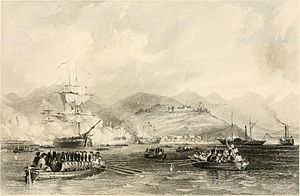
In late June 1840 the first part of the expeditionary force arrived in China aboard 15 barracks ships, four steam-powered gunboats and 25 smaller boats. The flotilla was under the command of Commodore Bremer. The British issued an ultimatum demanding the Qing Government pay compensation for losses suffered from interrupted trade and the destruction of opium, but were rebuffed by the Qing authorities in Canton.
In his letters, Palmerston had instructed the joint plenipotentiaries Elliot and his cousin Admiral George Elliot to acquire the cession of at least one island for trade on the Chinese coast. With the British expeditionary force now in place, a combined naval and ground assault was launched on the Chusan Archipelago. Zhoushan Island, the largest and best defended of the islands was the primary target for the attack, as was its vital port of Dinghai. When the British fleet arrived off Zhoushan, Elliot demanded the city surrender. The commander of the Chinese garrison refused the command, stating that he could not surrender and questioning what reason the British had for harassing Dinghai, as they had been driven out of Canton. Fighting began, a fleet of 12 small junks was destroyed by the Royal Navy, and British marines captured the hills to the south of Dinghai.
The British captured the city itself after an intense naval bombardment on 5 July forced the surviving Chinese defenders to withdraw. The British occupied Dinghai harbour and prepared to use it as a staging point for operations in China. In the fall of 1840 disease broke out in the Dinghai garrison, forcing the British to evacuate soldiers to Manila and Calcutta. By the beginning of 1841 only 1900 of the 3300 men who had originally occupied Dinghai were left, with many of those remaining incapable of fighting. An estimated 500 British soldiers died from disease, with the Cameron and Bengali volunteers suffering the most deaths, while the Royal Marines were relatively unscathed.
Having captured Dinghai, the British expedition divided its forces, sending one fleet south to the Pearl River while sending a second fleet north to the Yellow Sea. The northern fleet sailed to Peiho, where Elliot personally presented Palmerston's letter to the Emperor to Qing authorities from the capital. Qishan (ᡴᡳᡧᠠᠨ), a high-ranking Manchu official, was selected by the Imperial Court to replace Lin as the Viceroy of Liangguang after the latter was discharged for his failure to resolve the opium situation. Negotiations began between the two sides, with Qishan serving as the primary negotiator for the Qing and Elliot serving as the representative for the British Crown. After a week of negotiations, Qishan and Elliot agreed to relocate to the Pearl River for further negotiations. In return for the courtesy of the British to withdraw from the Yellow Sea, Qishan promised to requisition imperial funds as restitution for British merchants who had suffered damages. The war, however, was not concluded and both sides continued to engage each other. In the late spring of 1841 reinforcements arrived from India in preparation for an offensive against Canton. A flotilla of transports brought 600 men of the professionally trained 37th Madras Native Infantry to Dinghai, where their arrival boosted British morale. Accompanying the fleet as far as Macau was the newly constructed iron steamer HMS Nemesis, a weapon to which the Chinese navy had no effective counter. On 19 August three British warships and 380 marines drove the Chinese from the land bridge (known as "The Barrier") separating Macau from the Chinese mainland. The defeat of the Qing soldiers coupled with the arrival of the Nemesis in Macau's harbour resulted in a wave of pro-British support in the city. Portugal remained neutral in the conflict, but after the battle was willing to allow British ships to dock in Macau, a decision that granted the British a functioning port in Southern China. With the strategic harbours of Dinghai and Macau secured, the British began to focus on the war on the Pearl River. Five months after the British victory at Chusan, the northern elements of the expedition sailed south to Humen, known to the British as The Bogue. Bremer judged that gaining control of the Pearl River and Canton would put the British in a strong negotiating position with the Qing authorities, as well as allow for the renewal of trade when the war ended.
Pearl River campaign
While the British campaigned in the north, Qing Admiral Guan Tianpei greatly reinforced the Qing positions in Humen (Bocca Tigris), suspecting (sources state that Guan had been preparing for an eventual attack on the position since Napier's attack in 1835) that the British would attempt to force their way up the Pearl River to Canton. The Humen forts blocked transit of the river, and were garrisoned with 3000 men and 306 cannons. By the time the British fleet was ready for action, 10,000 Qing soldiers were in position to defend Canton and the surrounding area. The British fleet arrived in early January, and began to bombard the Qing defences at Chuenpi after a group of Chinese fire-rafts were sent drifting towards the Royal navy ships.
On 7 January 1841 the British won a decisive victory in the Second Battle of Chuenpi, destroying 11 Junks of the Chinese southern fleet and capturing the Humen forts. The victory allowed the British to set up a blockade of The Bogue, a blow that forced the Qing navy to retreat upriver.
Knowing the strategic value of Pearl River Delta to China and aware that British naval superiority made a reconquest of the region unlikely, Qishan attempted to prevent the war from widening further by negotiating a peace treaty with Britain. On 21 January Qishan and Elliot drafted the Convention of Chuenpi, a document which both parties hoped would end the war. The convention would establish equal diplomatic rights between Britain and China, exchange Hong Kong Island for Chusan, facilitate the release of shipwrecked and kidnapped British citizens held by the Chinese, and reopen trade in Canton by 1 February 1841. China would also pay six million silver dollars as recompense for the opium destroyed at Humen in 1838. However, the legal status of the opium trade was not resolved and instead left open to be discussed at a future date. Despite the success of the negotiations between Qishan and Elliot, both of their respective governments refused to sign the convention. The Daoguang Emperor was infuriated that Qing territory would be given up in a treaty that had been signed without his permission, and ordered Qishan arrested (he was later sentenced to death; the sentence was then commuted to military service.) Lord Palmerston recalled Elliot from his post and refused to sign the convention, wanting more concessions to be forced from the Chinese per his original instructions.
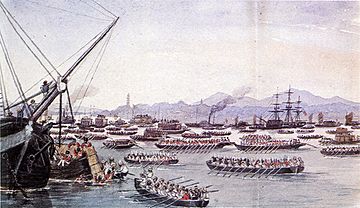
The brief interlude in the fighting ended in the beginning of February after the Chinese refused to reopen Canton to British trade. On 19 February a longboat from HMS Nemesis came under fire from a fort on North Wangtong Island, prompting a British response. The British commanders ordered another blockade of the Pearl River and resumed combat operations against the Chinese. The British captured the remaining Bogue forts on 26 February during the Battle of the Bogue and the Battle of First Bar on the following day, allowing the fleet to move further upriver towards Canton. Admiral Tianpei was killed in action during the fighting on 26 February. On 2 March the British destroyed a Qing fort near Pazhou and captured Whampoa, an action that directly threatened Canton's east flank. Major General Gough, who had recently arrived from Madras aboard HMS Cruizer, personally directed the attack on Whampoa. Superintendent Elliot (who was unaware that he had been dismissed), and the Governor-General of Canton declared a 3-day truce on 3 March. Between the 3rd and the 6th the British forces that had evacuated Chusan per the Convention of Chuenpi arrived in the Pearl River. The Chinese military was likewise reinforced, and by 16 March General Yang Fang commanded 30,000 men in the area surrounding Canton.
While the main British fleet prepared to sail up the Pearl River to Canton, a group of three warships departed for the Xi River estuary, intending to navigate the waterway between Macau and Canton. The fleet, led by Captain James Scott and Superintendent Elliot, was composed of the frigate HMS Samarang and the steamships HMS Nemesis and HMS Atalanta. Although the waterway was in places only 6 feet deep, the shallow drafts of the steamships allowed the British to approach Canton from a direction the Qing believed to be impossible. In a series of engagements along the river from 13 to 15 March, the British captured or destroyed Chinese ships, guns, and military equipment. 9 junks, 6 fortresses, and 105 guns were destroyed or captured in what was known as the Broadway expedition.
With the Pearl River cleared of Chinese defences, the British debated advancing on Canton. Although the truce had ended on 6 March, Superintendent Elliot believed that the British should negotiate with the Qing authorities from their current position of strength rather than risk a battle in Canton. The Qing army made no aggressive moves against the British and instead began to fortify the city. Chinese military engineers began to establish a number of mud earthworks on the riverbank, sank junks to create riverblocks, and started constructing fire rafts and gunboats. Chinese merchants were ordered to remove all of the silk and tea from Canton to impede trade, and the local populace was barred from selling food to the British ships on the river. On 16 March a British ship approaching a Chinese fort under a flag of truce was fired upon, leading to the British setting the fort on fire with rockets. These actions convinced Elliot that the Chinese were preparing to fight, and following the return of the ships of the Broadway expedition to the fleet, the British attacked Canton on 18 March, taking the Thirteen Factories with very few casualties and raising the Union Jack above the British factory. The city was partially occupied by the British and trade was reopened after negotiation with the Cohong merchants. After several days of further military successes, British forces commanded the high ground around Canton. Another truce was declared on 20 March. Against the advice of some of his captains, Elliot withdrew most of the Royal Navy warships downriver to the Bocca Tigris.
In mid April Yishan (Qishan's replacement as Viceroy of Liangguang and the Daoguang Emperor's cousin) arrived in Canton. He declared that trade should continue to remain open, sent emissaries to Elliot, and began to gather military assets outside Canton. The Qing army camped outside of the city soon numbered 50,000, and the money earned from the reopened trade was spent repairing and expanding Canton's defences. Concealed artillery batteries were built along the Pearl River, Chinese soldiers were deployed in Whampoa and the Bocca Tigris, and hundreds of small river craft were armed for war. A bulletin sent from the Daoguang Emperor commanded the Qing forces to "Exterminate the rebels at all points", and orders were given to drive the British from the Pearl River before reclaiming Hong Kong and driving the invaders out of China altogether. This order was leaked and became widely circulated in Canton among foreign merchants, who were already suspicious of Chinese intentions after learning of the Qing military buildup. In May many Cohong merchants and their families left the city, raising further concerns about a renewal of hostilities. Rumors spread that Chinese divers were being trained to drill holes in the hulls of British ships, and that fleets of fire rafts were being prepared for deployment against the Royal Navy. During the buildup the Qing army was weakened by infighting between units and lack of confidence in Yishan, who openly distrusted Cantonese civilians and soldiers, instead choosing to rely on forces drawn from other Chinese provinces. On 20 May Yishan issued a statement, asking the "people of Canton, and all foreign merchants who are respectfully obedient, not to tremble with alarm and be frightened out of their wits at the military hosts that are gathering around, there being no probability of hostilities." The next day Elliot requested that all British merchants evacuate the city by sundown, and several warships were recalled to their positions in front of Canton.
On the night of 21 May the Qing launched a coordinated night attack on the British army and navy. Artillery batteries hidden in Canton and on the Pearl River (many of which the British believed they had disabled earlier) opened fire, and Qing soldiers retook the British Factory. A large formation of 200 fire rafts connected by a chain was sent drifting towards the British ships at Canton, and fishing boats armed with matchlock guns began to engage the Royal Navy. The British warships were able to evade the attack, and stray rafts set Canton's waterfront on fire, illuminating the river and foiling the night attack. Downriver at Whampoa the Chinese attacked the British vessels at anchor there and attempted to prevent ships from reaching Canton. Having suspected an attack, (and as a consequence delaying his own offensive) Major General Gough consolidated the British forces at Hong Kong and ordered a rapid advance upriver to Canton. These reinforcements arrived on 25 May, and the British counter-attacked, taking the last four Qing forts above Canton and bombarding the city.
The Qing army fled in panic when the city heights were taken, and the British pursued them into the countryside. On 29 May a crowd of around 20,000 villagers and townspeople attacked and defeated a foraging company of 60 Indian sepoys in what became known as the Sanyuanli Incident, and Gough ordered a retreat back to the river. The fighting subsided on 30 May 1841 and Canton came fully under British occupation. Following the capture of Canton the British command and the governor-general of Canton agreed to a cease-fire in the region. Under the terms of the limited peace (later widely referred to as "The Ransom of Canton"), the British were paid to withdraw beyond the Bogue forts, an action they completed by 31 May. Elliott signed the peace treaty without consulting the British army or Navy, an act which displeased General Gough.
The defence of Canton was declared a diplomatic success by Yishan. In a letter to the Emperor, he wrote that the barbarians had begged "the chief general that he would implore the great Emperor in their behalf, that he would have mercy upon them, and cause their debts to be repaid them, and graciously permit them to carry on their commerce, when they would immediately withdraw their ships from the Bocca Tigris, and never dare again to raise any disturbance." However, General Yang Fang was reprimanded by the Emperor for his agreeing to a truce rather than forcefully resisting the British. The Emperor was not informed the British expedition had not been defeated and was very much intact. The imperial court continued to debate China's next course of action for the war, as the Daoguang Emperor wanted Hong Kong retaken.
Central China
Following their withdrawal from Canton, the British relocated the expeditionary force to Hong Kong. Just as with the Chinese commanders, the British leaders debated how the war should be continued. Elliot wanted to cease military operations and reopen trade, while Major General Gough wanted to capture the city of Amoy and blockade the Yangtze River. In July, a typhoon struck Hong Kong, damaging British ships in the harbour and destroying some of the facilities the expedition was building on the island. The situation changed when, on 29 July, Elliot was informed that he had been replaced as Superintendent by Henry Pottinger, who arrived in Hong Kong on 10 August to begin his administration. Pottinger wanted to negotiate terms with the Qing for the entire country of China, rather than just the Pearl River, and so he turned away Chinese envoys from Canton and gave permission for the expeditionary force to proceed with its war plans. Admiral Sir William Parker also arrived in Hong Kong to replace Humphrey Fleming Senhouse (who had died of a fever on 29 June) as the commander of the British naval forces in China. It was agreed by the British commanders that combat operations should be moved north to put pressure on Peking, and on 21 August the fleet sailed for Amoy.
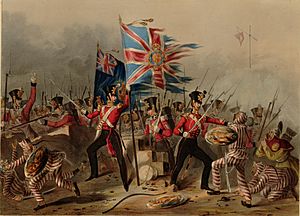
On 25 August, the British fleet entered the Jiulong River estuary and arrived at Amoy. The city was prepared for a naval assault, as Qing military engineers had built several artillery batteries into the granite cliffs overlooking the river. A purely naval assault was considered too risky by Parker, prompting Gough to order a combined naval and ground attack on the defences. On 26 August British marines and regular infantry (under the covering fire of the Royal Navy) flanked and destroyed the Chinese defences guarding the river. Several large British ships failed to destroy the largest of the Chinese batteries (which withstood over 12,000 cannonballs being fired at it), so the position was scaled and captured by the British infantry. The city of Amoy was abandoned on 27 August, and British soldiers entered the inner town where they blew up the citadel's powder magazine. 26 Chinese junks and 128 cannons were captured, with the captured guns being thrown into the river by the British. As Lord Palmerston wanted Amoy to become an international trade port at the end of the war, Gough ordered that no looting be tolerated and had officers enforce the death penalty for anyone found to be plundering. However, many Chinese merchants refused to ask for British protection out of fear of being branded as traitors to the Qing dynasty. The British withdrew to an island on the river, where they established a small garrison and blockaded the Jiulong River. With the city empty of any army, peasants, criminals, and deserters looted the town. The Qing army retook the city and restored order several days later, after which the city governor declared that a victory had been won and 5 British ships sunk.
In Britain, changes in Parliament resulted in Lord Palmerston being removed from his post as Foreign Minister on 30 August. William Lamb, 2nd Viscount Melbourne replaced him, and sought a more measured approach to the situation in China. Lamb remained a supporter of the war.
In September 1841, the British transport ship Nerbudda was shipwrecked on a reef off the northern coast of Taiwan after a brief gunnery duel with a Chinese fort. This sinking was followed by the loss of the brig Ann on another reef in March 1842. The survivors of both ships were captured and marched to southern Taiwan, where they were imprisoned. 197 were executed by Qing authorities on 10 August 1842, while an additional 87 died from ill-treatment in captivity. This became known as the Nerbudda incident.
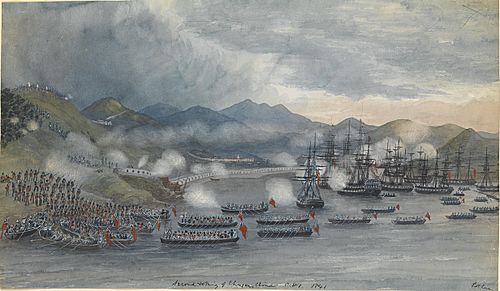
October 1841 saw the British solidify their control over the central Chinese coast. Chusan had been exchanged for Hong Kong on the authority of Qishan in January 1841, after which the island had been re-garrisoned by the Qing. Fearing that the Chinese would improve the island's defences, the British began a military invasion. The British attacked the Qing on 1 October. The battle of the Second Capture of Chusan ensued. The British forces killed 1500 Qing soldiers and captured Chusan. The victory reestablished British control over Dinghai's important harbour.
On 10 October a British naval force bombarded and captured a fort on the outskirts of Ningbo in central China. A battle broke out between the British army and a Chinese force of 1500 men on the road between the town of Chinhai and Ningbo, during which the Chinese were routed. Following the defeat, Chinese authorities evacuated Ningbo and the empty city was taken by the British on 13 October. An imperial cannon manufactory in the city was captured by the British, reducing the ability of the Qing to replace their lost equipment, and the fall of the city threatened the nearby Qiantang River. The capture of Ningbo forced the British command to examine their policy towards occupied Chinese territory and prizes of war. Admiral Parker and Superintendent Pottinger wanted a percentage of all captured Chinese property to be turned over to the British as legal prizes of war, while General Gough argued that this would only turn the Chinese population against the British, and that if property had to be seized, it should be public property rather than private. British policy eventually settled that 10% of all property captured by the British expeditionary forces would be seized as war loot in retaliation for injustices done to British merchants. Gough later stated that this edict would compel his men to "punish one set of robbers for the benefit of another."
Fighting ceased for the winter of 1841 while the British resupplied. False reports sent by Yishan to the Emperor in Beijing resulted in the continued British threat being downplayed. In late 1841 the Daoguang Emperor discovered that his officials in Canton and Amoy had been sending him embellished reports. He ordered the governor of Guangxi, Liang Chang-chü, to send him clear accounts of the events in Canton, noting that since Guangxi was a neighbouring province, Liang must be receiving independent accounts. He warned Liang that he would be able to verify his information by obtaining secret inquiries from other places. Yishan was recalled to the capital and faced trial by the imperial court, which removed him from command. Now aware of the severity of the British threat, Chinese towns and cities began to fortify against naval incursions.
In the spring of 1842 the Daoguang Emperor ordered his cousin Yijing to retake the city of Ningpo. In the ensuing Battle of Ningpo on 10 March the British garrison repelled the assault with rifle fire and naval artillery. At Ningpo the British lured the Qing army into the city streets before opening fire, resulting in heavy Chinese casualties. The British pursued the retreating Chinese army, capturing the nearby city of Cixi on 15 March.
The important harbour of Zhapu was captured on 18 May in the Battle of Chapu. A British fleet bombarded the town, forcing its surrender. A holdout of 300 soldiers of the Eight Banners stalled the advance of British army for several hours, an act of heroism that was commended by Gough.
Yangtze river campaign
With many Chinese ports now blockaded or under British occupation, Major General Gough sought to cripple the finances of the Qing Empire by striking up the Yangtze River. 25 warships and 10,000 men were assembled at Ningpo and Zhapu in May for a planned advance into the Chinese interior. The expedition's advance ships sailed up the Yangtze and captured the emperor's tax barges, a devastating blow that slashed the revenue of the imperial court in Beijing to a fraction of what it had been.

On 14 June, the mouth of the Huangpu River was captured by the British fleet. On 16 June, the Battle of Woosung occurred, after which the British captured the towns of Wusong and Baoshan. The undefended outskirts of Shanghai were occupied by the British on 19 June. Following the battle, Shanghai was looted by retreating Qing banner-men, British soldiers, and local civilians. Qing Admiral Chen Huacheng was killed while defending a fort in Woosong.
The fall of Shanghai left the vital city of Nanjing (Known as Jiangning under the Qing) vulnerable. The Qing amassed an army of 56,000 Manchu Banner-men and Han Green Standards to defend Liangjiang Province, and strengthened their river defences on the Yangtze. However, British naval activity in Northern China led to resources and manpower being withdrawn to defend against a feared attack on Beijing. The Qing commander in Liangjiang Province released 16 British prisoners with the hope that a ceasefire could be reached, but poor communications led both the Qing and the British to reject any overtures at peace. In secret, the Daoguang Emperor considered signing a peace treaty with the British, but only in regards to the Yangtze River and not the war as a whole. Had it been signed, the British forces would have been paid to not enter the Yangtze River.
On 14 July, the British fleet on the Yangtze began to sail up the river. Reconnaissance alerted Gough to the logistical importance of the city of Zhenjiang (Chinkiang), and plans were made to capture it. Most of the city's guns had been relocated to Wusong and had been captured by the British when said city had been taken. The Qing commanders inside the city were disorganised, with Chinese sources stating that over 100 traitors were executed in Zhenjiang prior to the battle. The British fleet arrived off of the city on the morning of 21 July, and the Chinese forts defending the city were blasted apart. The Chinese defenders initially retreated into the surrounding hills, causing a premature British landing. Fighting erupted when thousands of Chinese soldiers emerged from the city, beginning the Battle of Zhenjiang.
British engineers blew open the western gate and stormed into the city, where fierce street to street fighting ensued. Zhenjiang was devastated by the battle. The British suffered their highest combat losses of the war (36 killed) taking the city.
After capturing Zhenjiang, the British fleet cut the vital Grand Canal, paralysing the Caoyun system and severely disrupting the Chinese ability to distribute grain throughout the Empire. The British departed Zhenjiang on 3 August, intending to sail to Nanking. They arrived outside the Jiangning District on 9 August, and were in position to assault the city by 11 August. Although explicit permission to negotiate had not yet been granted by the emperor, Qing officials inside the city agreed to a British request to negotiate.
Treaty of Nanking
On 14 August a Chinese delegation led by the Manchu high court official Qiying (Kiying) and Llipu departed Nanking for the British fleet. Negotiations lasted for several weeks as the British delegation insisted the treaty be accepted by the Daoguang Emperor. The court advised the emperor to accept the treaty, and on 21 August the Daoguang Emperor authorised his diplomats to sign the peace treaty with the British. The First Opium war officially ended on 29 August 1842 with the signing of the Treaty of Nanking. The document was signed by officials of the British and Qing empires aboard HMS Cornwallis.
Technology and tactics
British
The British military superiority during the conflict drew heavily on the strength of the Royal Navy.
British warships carried more guns than their Chinese opponents and were manoeuvrable enough to evade Chinese boarding actions. Steam ships such as HMS Nemesis were able to move against winds and tides in Chinese rivers, and were armed with heavy guns and Congreve rockets. Several of the larger British warships in China (notably the third-rates HMS Cornwallis, HMS Wellesley, and HMS Melville) carried more guns than entire fleets of Chinese junks. British naval superiority allowed the Royal Navy to attack Chinese forts with very little risk to themselves, as British naval cannons out-ranged the vast majority of the Qing artillery.
British soldiers in China were equipped with Brunswick rifles and rifle-modified Brown Bess muskets, both of which possessed an effective firing range of 200–300 metres. British marines were equipped with percussion caps that greatly reduced weapon misfires and allowed firearms to be used in damp environments. In terms of gunpowder, the British formula was better manufactured and contained more sulphur than the Chinese mixture. This granted British weapons an advantage in terms of range, accuracy and projectile velocity. British artillery was lighter (owing to improved forging methods) and more manoeuvrable than the cannons used by the Chinese. As with the naval artillery, British guns out-ranged the Chinese cannon.
In terms of tactics, the British forces in China followed doctrines established during the Napoleonic Wars that had been adapted during the various colonial wars of the 1820s and 1830s. Many of the British soldiers deployed to China were veterans of colonial wars in India and had experience fighting larger but technologically inferior armies. In battle, the British line infantry would advance towards the enemy in columns, forming ranks once they had closed to firing range. Companies would commence firing volleys into the enemy ranks until they retreated. If a position needed to be taken, an advance or charge with bayonets would be ordered. Light infantry companies screened the line infantry formations, protecting their flanks and utilising skirmishing tactics to disrupt the enemy. British artillery was used to destroy the Qing artillery and break up enemy formations. During the conflict, the British superiority in range, rate of fire, and accuracy allowed the infantry to deal significant damage to their enemy before the Chinese could return fire. The use of naval artillery to support infantry operations allowed the British to take cities and forts with minimal casualties.
The overall strategy of the British during the war was to inhibit the finances of the Qing Empire, with the ultimate goal of acquiring a colonial possession on the Chinese coast. This was accomplished through the capture of Chinese cities and by blockading major river systems. Once a fort or city had been captured, the British would destroy the local arsenal and disable all of the captured guns. They would then move on to the next target, leaving a small garrison behind. This strategy was planned and implemented by Major General Gough, who was able to operate with minimal input from the British government after Superintendent Elliot was recalled in 1841. The large number of private British merchants and East India Company ships deployed in Singapore and the India colonies ensured that the British forces in China were adequately supplied.
Qing dynasty
China did not have a unified navy, instead allowing individual provinces to manage naval defenses. Although the Qing had invested in naval defences for their adjacent seas in earlier periods, after the death of the Qianlong Emperor in 1799, the navy decayed as more attention was directed to suppressing the Miao Rebellion and White Lotus Rebellion. These conflicts left the Qing treasury bankrupt. The remaining naval forces were badly overstretched, undermanned, underfunded and uncoordinated.
From the onset of the war, the Chinese navy was severely disadvantaged. Chinese war junks were intended for use against pirates or equivalent types of vessels, and were more effective in close range river engagements. Due to their ships' slow speeds, Qing captains consistently found themselves sailing towards much more maneuverable British ships, and as a consequence the Chinese could only use their bow guns. The size of the British ships made traditional boarding tactics useless, and the junks carried smaller numbers of inferior weaponry. In addition, the Chinese ships were poorly armoured; in several battles, British shells and rockets penetrated Chinese magazines and detonated gunpowder stores. Highly maneuverable steamships such as HMS Nemesis could decimate small fleets of junks, as the junks had little chance of catching up to and engaging the faster British steamers. The only western-style warship in the Qing Navy, the converted East Indiaman Cambridge, was destroyed in the Battle of First Bar.
Apparently the Chinese emperor was aware about this. In an 1842 edict he said:
... the invasion by the rebellious barbarians, they depended upon their strong ships and effective guns to commit outrageous acts on the seas and harm our people, largely because the native war junks are too small to match them. For this reason I, the Emperor, repeatedly ordered our generals to resist on land and not to fight on seas ... When the enemy ships come, no resistance can be offered; when they go away no means of pursuit are available ... In my opinion what the rebellious barbarians rely upon is the fact that Chinese war junks are incapable of going out to sea to fight them.
The defensive nature of the conflict resulted in the Chinese relying heavily on an extensive network of fortifications. The Kangxi Emperor (1654–1722) began the construction of river defences to combat pirates, and encouraged the use of western style cannons. By the time of the First Opium War, multiple forts defended most major Chinese cities and waterways. Although the forts were well armed and strategically positioned, the Qing defeat exposed major flaws in their design. The cannons used in the Qing defensive fortifications were a collection of Chinese, Portuguese, Spanish, and British pieces. The domestically produced Chinese cannon were crafted using sub-par forging methods, limiting their effectiveness in combat and causing excessive gun barrel wear. The Chinese blend of gunpowder also contained more charcoal than the British mixture did; while this made it more stable and thus easier to store, it also limited its potential as a propellant, decreasing projectile range and accuracy. Overall, Chinese cannon technology was considered to be 200 years behind that of the British.
Chinese forts were unable to withstand attacks by European weaponry, as they were designed without angled glacis and many did not have protected magazines. The limited range of the Qing cannon allowed the British to bombard the Qing defences from a safe distance, then land soldiers to storm them with minimal risk. Many of the larger Chinese guns were built as fixed emplacements and were unable to be maneuvered to fire at British ships. The failure of the Qing fortifications coupled with the Chinese underestimation of the Royal Navy allowed the British to force their way up major rivers and impede Qing logistics. Most notably, the powerful series of forts at Humen were well positioned to stop an invader from proceeding upriver to Canton, but it had not been considered that an enemy would attack and destroy the forts themselves, as the British did during the war.
At the start of the war the Qing army consisted of over 200,000 soldiers, with around 800,000 men being able to be called for war. These forces consisted of Manchu Bannermen, the Green Standard Army, provincial militias, and imperial garrisons. The Qing armies were armed with matchlocks and shotguns, which had an effective range of 100 metres. Chinese historians Liu and Zhang note that the Chinese soldiers "were equipped with sixty or seventy percent traditional weapons, of which the most important were the long lance, the side sword, the bow and arrow, and the rattan shield, and only thirty or forty percent [of their armament consisted of] gunpowder weapons, of which the most important were the matchlock musket, the heavy musket, the cannon, the fire arrow, and the earthshaking bomb and such things." Chinese soldiers were also equipped with halberds, spears, swords, and crossbows. The Qing dynasty also employed large batteries of artillery in battle.
The tactics of the Qing remained consistent with what they had been in previous centuries. Soldiers with firearms would form ranks and fire volleys into the enemy while men armed with spears and pikes would drive (described by the Chinese as Tuī (推) push) the enemy off of the battlefield. Cavalry was used to break infantry formations and pursue routed enemies, while Qing artillery was used to scatter enemy formations and destroy fortifications. During the First Opium War, these tactics were unable to successfully deal with British firepower. Chinese melee formations were decimated by artillery, and Chinese soldiery armed with matchlocks could not effectively exchange fire with British ranks, who greatly outranged them. Most battles of the war were fought in cities or on cliffs and riverbanks, limiting the Qing usage of cavalry. Many Qing cannon were destroyed by British counter-battery fire, and British light infantry companies were consistently able to outflank and capture Chinese artillery batteries. A British officer said of the opposing Qing forces, "The Chinese are robust muscular fellows, and no cowards; the Tartars [i.e. Manchus] desperate; but neither are well commanded nor acquainted with European warfare. Having had, however, experience of three of them, I am inclined to suppose that a Tartar bullet is not a whit softer than a French one."
The strategy of the Qing dynasty during the war was to prevent the British from seizing Chinese territory. This defensive strategy was hampered by the Qing severely underestimating the capacity of the British military. Qing defences on the Pearl and Yangtze rivers were ineffective in stopping the British push inland, and superior naval artillery prevented the Chinese from retaking cities. The Qing imperial bureaucracy was unable to react quickly to the prodding British attacks, while officials and commanders often reported false, faulty, or incomplete information to their superiors. The Qing military system made it difficult to deploy troops to counter the mobile British forces. In addition, the ongoing conflict with Sikhs on the Qing border with India drew away some of the most experienced Qing units from the war with Britain.
Aftermath
The war ended in the signing of China's first Unequal Treaty, the Treaty of Nanking. In the supplementary Treaty of the Bogue, the Qing empire also recognised Britain as an equal to China and gave British subjects extraterritorial privileges in treaty ports. In 1844, the United States and France concluded similar treaties with China, the Treaty of Wanghia and Treaty of Whampoa, respectively.
Was the war inevitable?
Historians have often pondered whether the war could have been avoided. One factor was that China rejected diplomatic relations with the British or anyone else, as seen in the rejection of the Macartney mission in 1793. As a result, diplomatic mechanisms for negotiation and resolution were missing. Michael Greenberg locates the inevitable cause in the momentum for more and more overseas trade in Britain's expanding modern economy. On the other hand, the economic forces inside Britain that were war hawks, Radicals in Parliament and northern merchants and manufacturers, were a political minority and needed allies, especially Palmerston, before they could get their war. In Parliament, the Melbourne government faced a host of complex international threats including the Chartist riots at home, bothersome budget deficits, unrest in Ireland, rebellions in Canada and Jamaica, war in Afghanistan, and French threats to British business interests in Mexico and Argentina. The opposition demanded more aggressive answers, and it was Foreign Minister Palmerston who set up an easy war to solve the political crisis. It was not economics or expanding trade that caused the British to go to war, Melancon argues, but it was more a matter of upholding aristocratic standards of national honour sullied by Chinese insults.
See also
 In Spanish: Primera Guerra del Opio para niños
In Spanish: Primera Guerra del Opio para niños
- Illustrated Treatise on the Maritime Kingdoms
- Second Opium War
- Tea in the United Kingdom History – 18th century
- History of tea#United Kingdom
Individuals
- Lin Zexu
- William Jardine (merchant)
- William Napier, 9th Lord Napier
- David Sassoon
Contemporaneous Qing-dynasty wars
- Sino-Sikh War (1841–1842)


